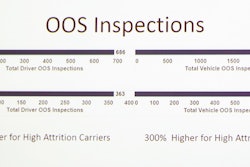During the Trucking Solutions Group conference call with Anne Ferro a week ago, owner-operator Henry Albert posed an idea that seemed like it may have been new to Ferro: adding a Behavioral Analysis and Safety Improvement Category (BASIC) to areas of carrier evaluation in the Compliance, Safety, Accountability (CSA) program. Albert proposed that carriers be ranked in an “8th BASIC,” as it were, according to their turnover rates.
It’s an idea that I’ve heard before, and Albert referenced the same source: David Owen, President of the National Association of Small Trucking Companies. We first talked about the notion last October, when I met with Owen while researching this story, about the relative advantages/disadvantages of percentage and mileage pay packages and various carriers that offer owner-operators a choice between the two.
“The lack of experienced drivers” around the nation Owen called the “biggest safety problem” in the industry. The opposite, he said, was his small-carrier members’ bread and butter. The reason small carriers continue to thrive is their ability to attract and retain good professional drivers. “They can find drivers and keep them,” Owen told me, with “a strong personal and professional relationship between the company owner and driver.”

A BASIC based on driver turnover, Owen said, “would level the playing field” by showing exactly which carriers were keeping their drivers happiest — and the safest, assuming a link between the two. According to data from FMCSA itself, the assumption is indeed a safe one — conclusions of agency research reaching back to 2003 concluded thusly:
It may be concluded from the results of this research that a significant relationship exists between job change rate and crash involvement. There is evidence that drivers, whose (verified) employment history indicates that they have averaged more than two jobs with different carriers each year for a period of two years or more deserve special scrutiny during the hiring process to determine whether there are mitigating circumstances that have placed the individual in an increased-risk category.
Follow that logic and carriers that would encourage such churn might also deserve “special scrutiny,” eh?
When Albert introduced the 8th BASIC notion during the Trucking Solutions Group call last week, as I’d expected Ferro made note that driver turnover rates for individual carriers were not stats the FMCSA reliably and readily has access to. But I posed that same notion to Owen last year, and theoretically, at least, he pointed out that a cross-reference of employment data from the IRS and FMCSA’s drug-testing information could well do the trick.
What do you think?














